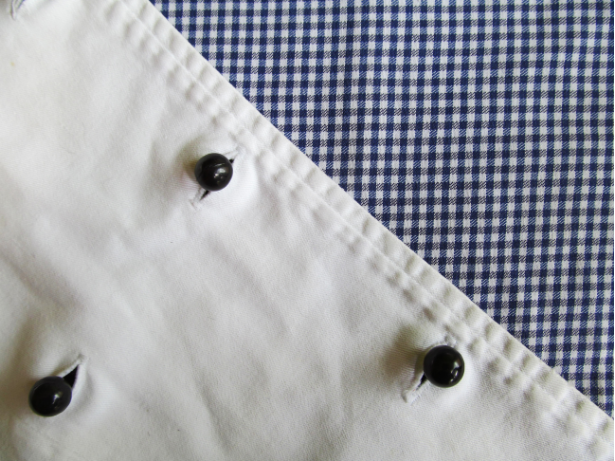Maintaining pristine chef whites is a badge of honour for culinary professionals, symbolising hygiene, expertise, and dedication in the kitchen. Knowing how to clean chef whites, therefore, is crucial, as custom chef whites and personalised aprons face the inevitable challenge of stains and spills that come with the territory.
This guide will walk you through the essential steps on how to clean chef jackets and keep them nice and fresh, ensuring you always present a professional image while feeling confident and comfortable at work.
Contents
- What are Chef Whites?
- The Importance of Acting Immediately
- General Washing Advice
- How to Clean Chef Whites
- Drying and Ironing
- Common Mistakes to Avoid
- Preventive Care
- More Custom Workwear at Clothes2order
What are Chef Whites?
With their rich history, chef whites play a significant role in the culinary world. The traditional white uniform was popularised by French chef, Marie-Antoine Carême, in the mid-19th century, who believed that cleanliness and professionalism were paramount in the kitchen.
As in literature and art, the classic white colour symbolises purity, and, on a more practical level, serves as a visual reminder (and proof) of the chef’s commitment to hygiene. Since then, these uniforms have become a universal standard, representing the discipline and skill required of the culinary arts.
The materials and fabric used for chef whites are carefully chosen to meet the demands of a busy kitchen environment. Typically made from high-quality cotton or a cotton-polyester blend, these fabrics are durable, breathable, and easy to clean. Cotton is favoured for its comfort and absorbency, while the addition of polyester enhances the garment’s stain resistance and longevity.
This combination ensures that chef whites can withstand frequent washing and the rigours of daily use, while still providing the professional appearance essential to the role.
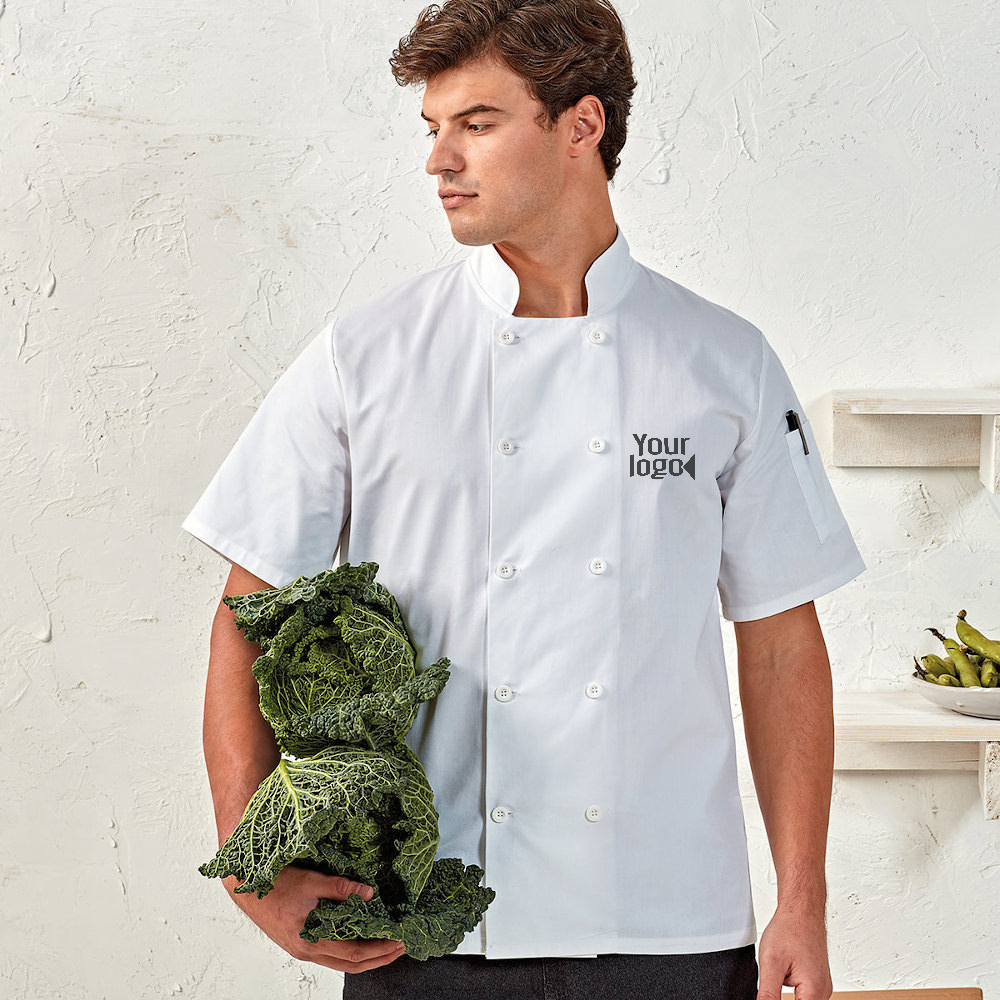
The Importance of Acting Immediately
When it comes to maintaining the pristine appearance of your chef whites, taking immediate action is crucial. Addressing any stains as soon as they occur can prevent them from setting into the fabric, making them easier to remove later. The longer a stain sits, the more it bonds with the fibres, becoming increasingly difficult to eliminate. So if you want to keep your uniform looking professional and clean, you can preserve its appearance and extend its lifespan via prompt reactions and pre-treatment. Continue reading to find our best tips on how to clean chef jackets.
General Washing Advice
Sorting and Preparing
Now, you probably already know to do this. But just as a reminder: don’t forget to separate whites from coloured garments before washing to prevent dye bleeding and damage. You should also turn chef jackets and trousers inside out to protect delicate surfaces and preserve any custom logos on personalised workwear.
And, most importantly, you’ll need to check for stains and pre-treat them to ensure optimal cleaning during the wash cycle.
Choosing Detergents
In terms of detergents, you should select ones designed for white or light-coloured fabrics (with brightening agents to enhance whiteness). Keep an eye out for enzyme-based formulas, because these are the most effective at breaking down protein-based stains common in kitchens. And, contrary to what you may believe, you should also try to avoid bleach unless strictly necessary, as it may weaken fabric fibres and cause yellowing over time.
Washing Machine Settings
Use a gentle or delicate cycle to minimise agitation and reduce wear on the garments. Set the machine to the hottest water temperature recommended for the fabric to dissolve grease and remove stains effectively. Consider adding an extra rinse cycle to ensure all detergent residue is removed for clean, fresh chef whites.
Watch our handy guide to how to wash your custom branded clothing below:
How to Clean Chef Whites
Due to the nature of your culinary role, knowing how to get stains out of your chef whites is vital to the overall maintenance of your uniform.
Grease Stains (Oil, Butter, Fat)
- Immediate Action: Blot the stain gently with a paper towel to absorb excess grease. Avoid rubbing, as this can spread the stain.
- Pre-treatment: Apply a small amount of liquid dish detergent directly to the stain. Dish detergents are designed to cut through grease, making them highly effective. Gently work the detergent into the stain with your fingers or a soft brush and let it sit for 10-15 minutes.
- Washing: Wash the garment in the hottest water safe for the fabric. Use an enzyme-based laundry detergent for added effectiveness against grease. Check the stain before drying; if it remains, repeat the pre-treatment and washing steps.
Wine Stains (Red and White Wine)
- Immediate Action: Blot the stain with a clean cloth to absorb as much wine as possible. For red wine, sprinkle salt or baking soda on the stain to absorb the liquid.
- Pre-treatment: Rinse the stained area with cold water from the back of the fabric to push the stain out. For red wine, create a mixture of equal parts hydrogen peroxide and liquid dish soap, and apply it to the stain. Let it sit for a few minutes, then blot with a clean cloth. For white wine, apply a liquid laundry detergent directly to the stain and let it sit for 10 minutes.
- Washing: Wash the garment in cold water with a regular laundry detergent. If the stain persists, repeat the pre-treatment process before drying.
Vegetable Stains (Tomato, Beetroot, Spinach)
- Immediate Action: Rinse the stain with cold water to remove any excess vegetable matter.
- Pre-treatment: For tomato stains, apply a liquid laundry detergent directly to the stain and let it sit for 10 minutes. For beetroot stains, create a paste of baking soda and water, apply it to the stain, and let it sit for 15 minutes. For spinach or other leafy green stains, apply a mixture of white vinegar and water to the stain, let it sit for 10-15 minutes, then rinse.
- Washing: Wash the garment in the hottest water safe for the fabric, using a regular laundry detergent. For stubborn stains, you can add a stain remover to the wash cycle. Check the stain before drying; if it remains, repeat the pre-treatment and washing steps.
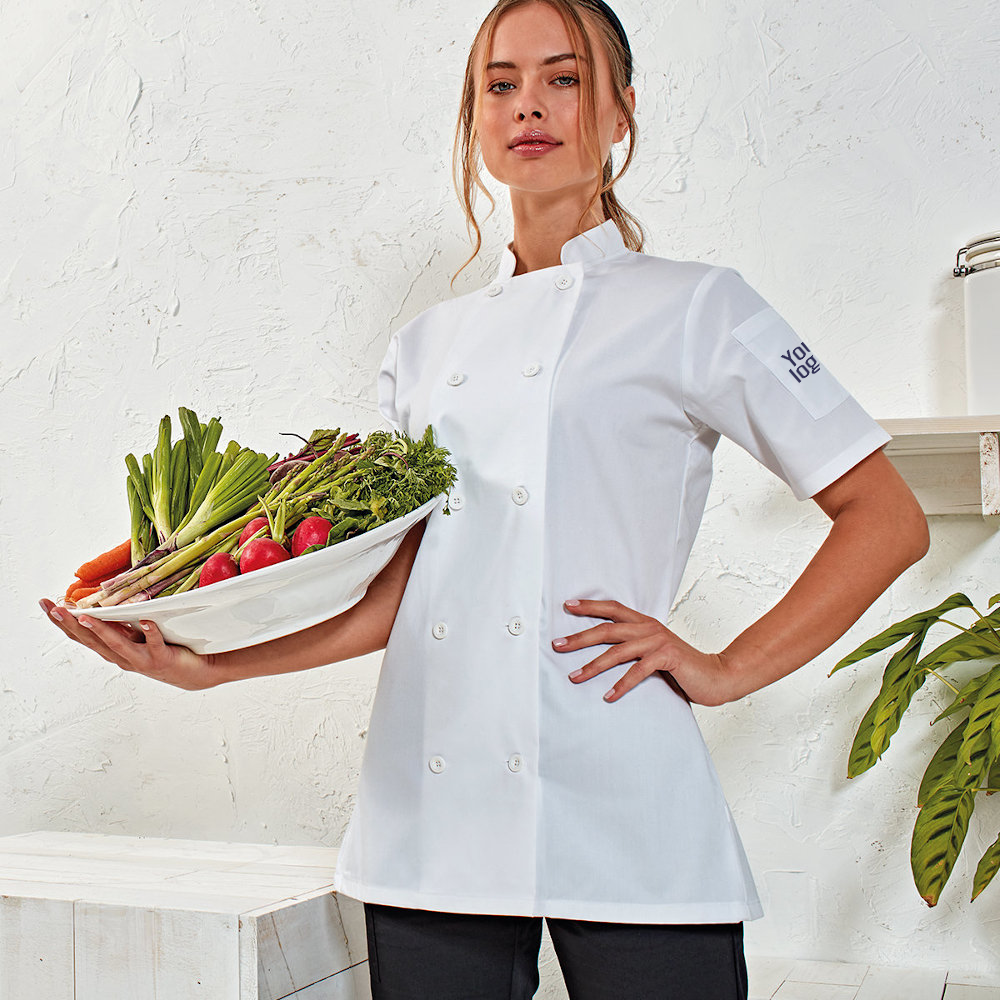
Protein Stains (Eggs, Dairy, Blood)
- Immediate Action: Soak the stained area in cold water for at least 30 minutes. Avoid hot water, as it can set protein stains.
- Pre-treatment: Apply a mixture of cold water and a few drops of enzyme-based laundry detergent to the stain. Let it sit for 15-20 minutes.
- Washing: Wash in cold water with an enzyme-based detergent.
Tomato-Based Stains (Sauce, Ketchup)
- Immediate Action: Scrape off any excess tomato sauce with a spoon or dull knife.
- Pre-treatment: Rinse the stain with cold water from the back of the fabric to push the stain out of the fibres. Apply a liquid laundry detergent directly to the stain and let it sit for 10 minutes.
- Washing: Wash in the hottest water safe for the fabric, with an enzyme-based detergent.
Coffee and Tea Stains
- Immediate Action: Blot the stain with a clean cloth to absorb as much liquid as possible.
- Pre-treatment: Mix one tablespoon of white vinegar with one tablespoon of liquid dish soap and two cups of warm water. Apply the solution to the stain with a sponge, then blot with a clean cloth until the stain is removed.
- Washing: Wash in warm water with a regular laundry detergent.
Chocolate and Cocoa Stains
- Immediate Action: Scrape off any excess chocolate with a spoon or dull knife.
- Pre-treatment: Apply liquid laundry detergent directly to the stain and let it sit for 10 minutes. For stubborn stains, use a mixture of equal parts white vinegar and water.
- Washing: Wash in warm water with a regular laundry detergent.
Ink Stains
- Immediate Action: Place a paper towel under the stained area to prevent the ink from spreading.
- Pre-treatment: Apply rubbing alcohol or hand sanitiser to the stain, blotting with a clean cloth until the ink begins to lift.
- Washing: Wash in the hottest water safe for the fabric, using a regular laundry detergent.
Curry Stains
- Immediate Action: Rinse the stain with cold water from the back of the fabric to push the stain out of the fibres.
- Pre-treatment: Apply a paste made from baking soda and water to the stain, let it sit for 15 minutes, then rinse.
- Washing: Wash in the hottest water safe for the fabric, with a regular laundry detergent.
Sweat and Deodorant Stains
- Immediate Action: Rinse the stained area with cold water.
- Pre-treatment: Apply a mixture of equal parts white vinegar and water to the stain. Let it sit for 30 minutes.
- Washing: Wash in the hottest water safe for the fabric, with a regular laundry detergent.
Hand Washing
If you prefer doing things yourself, or have limited access to a washing machine, you can also wash your chef whites by hand.
Start by filling a basin or sink with lukewarm water and add a small amount of detergent. Submerge the chef whites in the soapy water and gently agitate them to loosen dirt and stains. Pay special attention to areas prone to staining, such as cuffs, collars, and pockets.
After soaking for a few minutes, rinse the garments thoroughly with clean water to remove any soap residue. Press out excess water and hang the chef whites to air dry, avoiding direct sunlight to prevent yellowing.
By hand washing chef whites with care, you can achieve excellent results while preserving the integrity of the fabric.
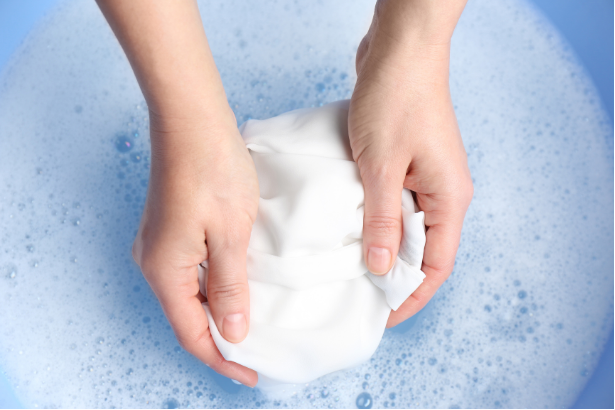
Drying and Ironing
Drying Methods
Air drying and machine drying are common methods for drying chef whites. Air drying is gentle and helps preserve fabric integrity, while machine drying offers convenience.
Use low or medium heat settings for machine drying to prevent damage.
Ironing Tips
Iron chef whites while slightly damp for best results. Set the iron to the appropriate temperature to avoid damage.
Pay attention to collars, cuffs, and seams while ironing.
Storage Suggestions
Store chef whites on padded hangers to maintain shape and prevent creasing. Avoid folding to prevent permanent wrinkles.
Store in a cool, dry place away from sunlight and moisture.
Common Mistakes to Avoid
Bleach Usage
Using bleach can effectively remove tough stains and disinfect chef whites. However, bleach can weaken fabric fibres over time and may cause yellowing or discolouration. Consider using bleach alternatives or limiting bleach usage to occasional deep cleaning to preserve the integrity of the fabric.
Overloading the Machine
Avoid overloading the washing machine when laundering chef whites. Overloading can prevent proper agitation and rinsing, leading to ineffective cleaning and potential damage to the garments. Follow the manufacturer’s guidelines for load size to ensure thorough cleaning and maintain the quality of chef whites.
Ignoring Care Labels
Ignoring care labels can result in damage to chef whites and premature wear. Always follow care label instructions for washing temperature, detergent type, and drying methods to extend the life of the garments. Proper care according to care labels helps preserve fabric integrity and ensures chef whites remain clean and professional-looking.
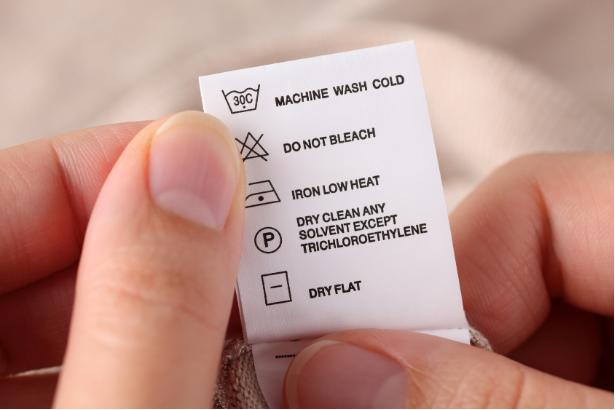
Preventive Care
Protective Measures
Wearing personalised aprons and other protective gear is essential for minimising the risk of substances staining your clean chef whites. Aprons provide an extra layer of protection against spills and splatters in the kitchen. Invest in high-quality aprons made from durable materials for long-term stain prevention.
Regular Maintenance
Regular maintenance is key to keeping chef whites looking their best over time. Promptly address stains with appropriate pre-treatment methods. Wash chef whites after each use to prevent stains from setting in and to maintain freshness.
Professional Cleaning Services
Consider professional cleaning services for deep cleaning and stain removal. Professional cleaners have the expertise and equipment to effectively remove stubborn stains and odours. Schedule professional cleaning periodically to prolong the life of chef whites and ensure they remain in pristine condition.
More Custom Workwear at Clothes2order
In the culinary world, custom chef whites aren’t just about appearance – they’re a symbol of professionalism and dedication. By following the tips we’ve outlined above on how to clean chef whites, you can ensure they remain in pristine condition for the long haul.
And if you’re looking to stock up on new gear, be sure to check out the range of custom clothing available at Clothes2order.com, with personalised chef hats, men’s workwear, women’s workwear and more available for printing and embroidery. Don’t be afraid to contact us with any further questions about your customisation and care needs!

